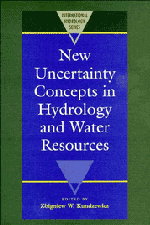Book contents
- Frontmatter
- Contents
- List of Authors
- Preface
- I INTRODUCTION
- II FACETS OF UNCERTAINTY
- III NOVEL APPROACHES TO UNCERTAINTY: FRACTALS, FUZZY SETS AND PATTERN RECOGNITION, NON-PARAMETRIC METHODS
- 1 Dispersion in stratified soils with fractal permeability distribution
- 2 Multifractals and rain
- 3 Is rain fractal?
- 4 Multifractal structure of rainfall occurrence in West Africa
- 5 Analysis of high-resolution rainfall data
- 6 Application of fuzzy theory to snowmelt runoff
- 7 On the value of fuzzy concepts in hydrology and water resources management
- 8 Application of neural network in groundwater remediation under conditions of uncertainty
- 9 Application of pattern recognition to rainfall–runoff analysis
- 10 Nonparametric estimation of multivariate density and nonparametric regression
- 11 Nonparametric approach to design flood estimation with pre-gauging data and information
- IV RANDOM FIELDS
- V TIME SERIES AND STOCHASTIC PROCESSES
- VI RISK, RELIABILITY AND RELATED CRITERIA
11 - Nonparametric approach to design flood estimation with pre-gauging data and information
Published online by Cambridge University Press: 07 May 2010
- Frontmatter
- Contents
- List of Authors
- Preface
- I INTRODUCTION
- II FACETS OF UNCERTAINTY
- III NOVEL APPROACHES TO UNCERTAINTY: FRACTALS, FUZZY SETS AND PATTERN RECOGNITION, NON-PARAMETRIC METHODS
- 1 Dispersion in stratified soils with fractal permeability distribution
- 2 Multifractals and rain
- 3 Is rain fractal?
- 4 Multifractal structure of rainfall occurrence in West Africa
- 5 Analysis of high-resolution rainfall data
- 6 Application of fuzzy theory to snowmelt runoff
- 7 On the value of fuzzy concepts in hydrology and water resources management
- 8 Application of neural network in groundwater remediation under conditions of uncertainty
- 9 Application of pattern recognition to rainfall–runoff analysis
- 10 Nonparametric estimation of multivariate density and nonparametric regression
- 11 Nonparametric approach to design flood estimation with pre-gauging data and information
- IV RANDOM FIELDS
- V TIME SERIES AND STOCHASTIC PROCESSES
- VI RISK, RELIABILITY AND RELATED CRITERIA
Summary
ABSTRACT The main task of flood frequency analysis is to obtain design flood magnitudes from a streamflow record. The gauged record is rarely long enough to yield an estimate of an extreme flood which is sufficiently accurate to be applied with confidence in hydraulic engineering. Therefore extending a data record back in time using historical or palaeoflood data has the potential to provide a considerable amount of additional information on very large floods. Parametric estimation methods are readily applicable to flood frequency analysis when pre-gauging data is available. However, all parametric approaches need an assumption about the underlying parent distribution which is never known in hydrologic processes. A new nonparametric kernel estimation model is proposed and developed. With limited real data and simulation experiments, results show that quantiles estimated by nonparametric methods are better than those obtained by some selected parametric estimators both in terms of the descriptive ability and predictive ability. The choice of the optimum kernel function, the uncertainty of the threshold of perception value and the difference between fixed kernel and variable kernel estimators are also discussed. It is expected that the nonparametric approach will be widely used in practice as it is free of serious limitations of classical parametric models.
INTRODUCTION
Statistical methods of flood frequency estimation in current use are mainly based on the assumption that observed flood series comes from a population whose probability density function is known.
- Type
- Chapter
- Information
- New Uncertainty Concepts in Hydrology and Water Resources , pp. 151 - 160Publisher: Cambridge University PressPrint publication year: 1995

